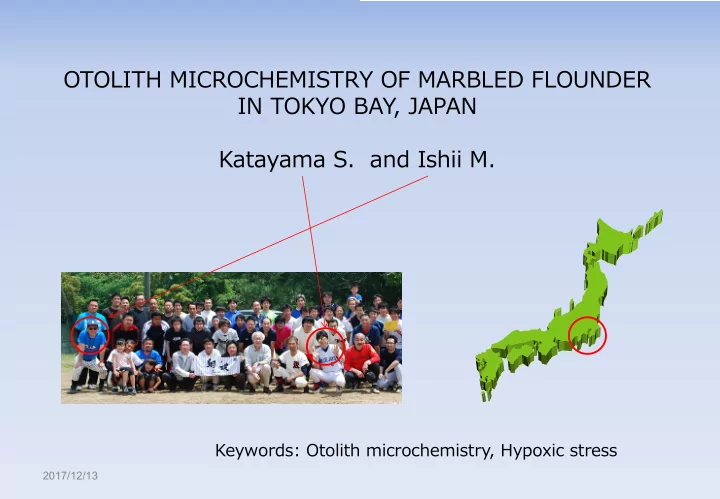

OTOLITH MICROCHEMISTRY OF MARBLED FLOUNDER IN TOKYO BAY , JAPAN Katayama S. and Ishii M. Keywords: Otolith microchemistry, Hypoxic stress 2017/12/13
Marbled frounder 2011 Ijmuiden Pseudopleuronectes yokohamae Several populations showed synchronized interannual variations in abundance, in spite of the genetic differentiation.
Purposes: Though the fishery targeting the flounder had been closed in the several years, the stock has not recovered in Tokyo Bay. In the research project on the ecosystem-network, we examined population structure of the flounder in and around Tokyo Bay by otolith microchemistry. 200 Kanagawa Pref . 150 ton) ( C atch 100 50 0 1988 1989 1990 1991 1992 1993 1994 1995 1996 1997 1998 1999 2000 2001 2002 2003 2004 2005 2006 2007 2008 2009 2010 2017/12/13
Characteristics of marbled flounder life >>>Adhesive demersal eggs >>>Habitat in bottom layer at drifting phase Ontogenetic distribution and juvenile migration to escape from hypoxic waters in Tokyo Bay >>>See poster session HOW DOES MARBLED SOLE (PLEURONECTES YOKOHAMAE) RELATE TO TOKYO BAY SURROUNDED BY THE METROPOLITAN AREAS Ishii, M., Kajiyama, M., Katayama, S., Hori, M. 2017/12/13
OTOLITH MICROCHEMISTRY OF MARBLED FLOUNDER IN TOKYO BAY , JAPAN Sr analysis (EPMA) did not indicate area- specific traits in the otolith. We employed other methods which revealed environmental history. ⇒ LA/ICP-ms analysis of multi-elemant traces
Otolith Profile along annuli ICP-MS Laser abration Causes on the fluctuation in elemental concentration, except for Sr, have been disclosed. They may display area-specific traits Element composition of otolith in geranal (wt %) Ca: 38.8% Sr: 0.236% Na: 0.223% K: 0.0282% Mg: 0.0021% Ba: 0.00029% Cu: 0.000074% Zn: 0.000047% Cd: 0.0000023%
LA/ICP-MS analysis Profile were obtained scan data Interval 50μm, Spot diameter 30μm, wave length 213nm Ca, Sr, Na, K, Mg, Ba, Cu, Zn, Cd, Mn Detectable metals 100 50 0 Ca Sr Na K Mg Ba Cu Zn Cd Mn
1 Ba/Ca Mn/Ca Mg/Ca 0.5 0 1 Ba/Ca Mn/Ca Mg/Ca 0.5 0 1 Ba/Ca Mn/Ca Mg/Ca 0.5 Relatively stable at low level 0 Outside of Tokyo Bay Core → → Edge
1 1 Annulus Ba/Ca Ba/Ca Mn/Ca Mn/Ca Mg/Ca Mg/Ca 0.5 0.5 0 0 1 1 Ba/Ca Ba/Ca Mn/Ca Mn/Ca Mg/Ca Mg/Ca 0.5 0.5 0 0 Core → → Edge 1 Ba/Ca Mn showed sudden increase Mn/Ca during 0+ life period. Mg/Ca Mn and Mg sycronizely 0.5 decreased after 1+. Inner area Left: 2009, right: 2011 year class 0
Mn and Mg show synchronized fluctuations. Annulus 1 1 Sudden increases occur in Mn. Ba/Ca Ba/Ca Mn/Ca Mn/Ca Mg/Ca Mg/Ca 0.5 0.5 0 0 1 1 Ba/Ca Ba/Ca Mn/Ca Mn/Ca Mg/Ca Mg/Ca 0.5 0.5 0 0 1 1 Ba/Ca Ba/Ca Mn/Ca Mn/Ca Mg/Ca Mg/Ca 0.5 0.5 0 0 Mid-area Left: 2009, right: 2011 year class
To examine the factors of fluctuations in the otolith microchemistry, coexisted demersal fishes were analyzed. Goby ヒメハゼ Favonigobius gymnauchen TL:40-60mm(0+) Dragonet ハタタテヌメリ Callionymus valenciennei TL:50-70mm(0+) Collected in early April in 2016 Water depth 5-10m
Core → → Edge Core → → Edge Mid-area, Goby 20160405 Mid-area, Dragonet 20160405
Inner area, Dragonet 20160402 Mid-area, Dragonet 20160405 Mn and Mg show synchronized fluctuations. Sudden increases occur in Mn and Mg.
0.8 Mn/Ca 0.7 Marbled 0.6 flounder 0.5 0.4 0.3 0.2 0.1 0 A1 A2 A3 B2 B3 B5 C5 C6 D1 D2 D3 CH1 CH2 CH3 -0.1 Inner area Mid-area Outside 1.2 Dragonet, Goby Mn/Ca 1 0.8 0.6 0.4 Large fluctuations within otoliths, among 0.2 areas, and among fish species 0 >>> Hypoxic waters and/or the environmental stresses occurred in the Inner area Mid-area Mid-area inner bay. (Dragonet) (Goby) (Dragonet)
Rearing experiment Submission of this abstract Transportation to the laboratory Hypoxic treatment, 45-50% of oxygen concentration, for overnight of three times Total length (mm) Before hypoxic treatment After the treatment Cont. 42.3 mm (±3.5) 45.9 mm ( ± 4.4) Treat. 48.6 mm ( ± 2.5) Body weight (g) Cont. 1.04 g ( ± 0.32) 1.35 g ( ± 0.33) Treat. 1.58 g ( ± 0.25)
ALC-marking at the Sr marking at the commence of end of hypoxic hypoxic experiment experiment Measured spots of otolith 2017/12/13 formed under low oxygen
Ba/Ca Ba/Sr Ba/Ca Ba/Sr Mn/Sr Mn/Ca Mn/Ca Mn/Sr Mg/Ca Mg/Sr Mg/Ca Mg/Sr Core → Edge Control Hypoxic treatment Core → Edge
Ba/Ca Mn/Ca Hypoxic stress made significant increases of Mn and Mg in the otoliths. Before hypoxic Mg/Ca treatment My assumption were confirmed, after my submission of abstract. During the treatment Control
Conclusions Through the LA-ICP/ms analysis, significant difference was detected between the flounder from the inside and the outside of Tokyo Bay. Otolith from the outside had little amount of trace metals, whereas high concentrations of Mn, Mg and Ba were found from the inside. These metals showed large fluctuation within otoliths, among areas, and among fish species, suggesting that these variations would depend on hypoxic waters and/or the environmental stresses occurred in the inner bay. Through the rearing experiments, hypoxic stress made significant increases of Mn and Mg in the otoliths. Otolith microchemistry of demersal fishes such as flatfishes provides a new insight for understanding environmental effects on the fishing grounds and nursery areas suffered from the spread of oxygen-depleted water in inner bays.
Recommend
More recommend